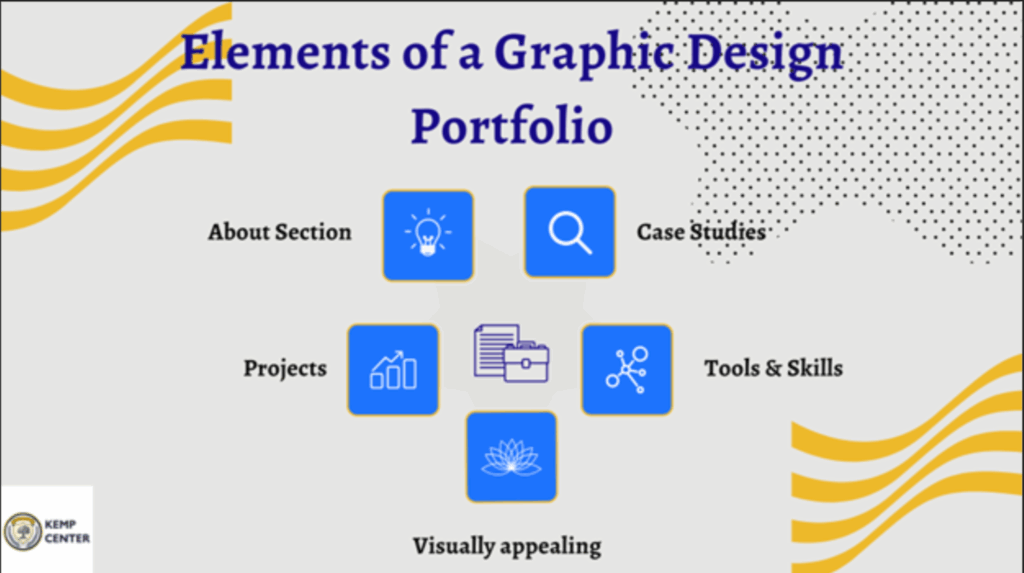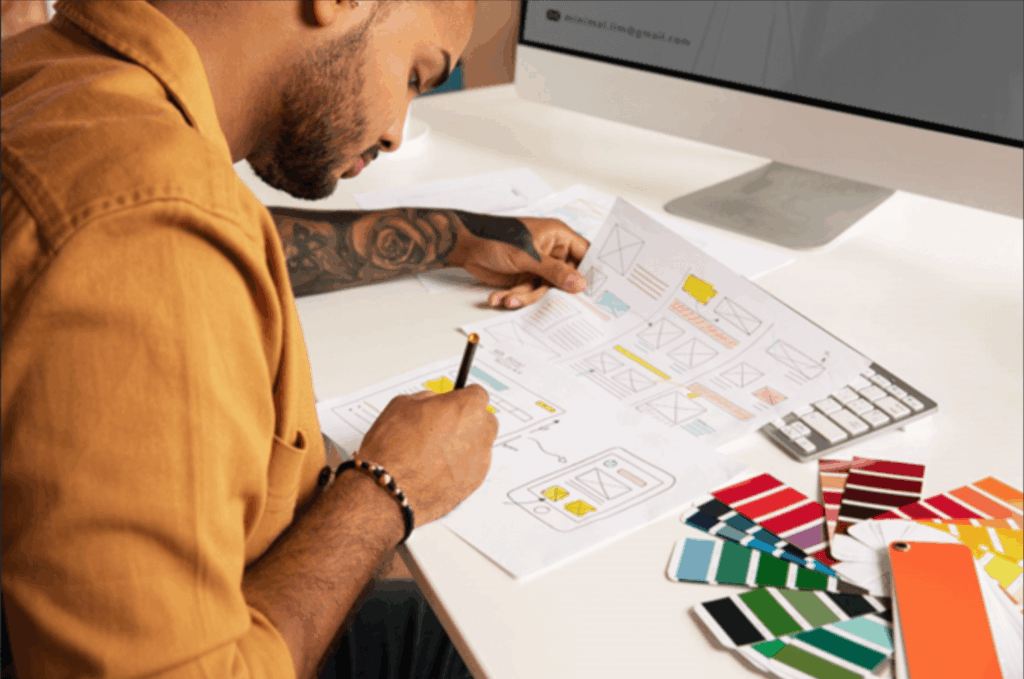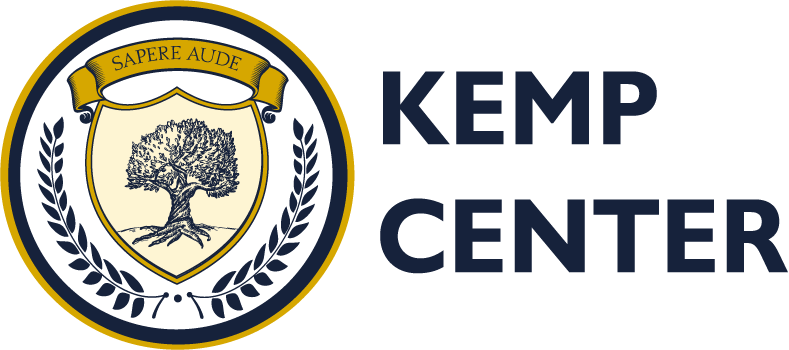Portfolio of a Graphic Designer - Stay Attractive In The Labour Market

Table of Contents
The need for graphic design in various industries has resulted in more competition among graphic designers than we have ever seen before. To stay relevant and employable in the labour market, having a compelling portfolio is now a must!
A compelling portfolio goes way beyond your compilation of work; it encompasses your brand statement, a visual résumé, and a tool that speaks on your behalf when you’re not in the room. This collection is what employers, clients, collaborators, and creative directors use to assess what you bring to the table; your creative process, design skills, and potential value.
In this article, I’ll cover a detailed guide on what makes a standout graphic design portfolio, the qualities your employers are really looking for, and how you can keep your portfolio fresh, effective, and market-ready, so you stay attractive in the labour market.
Why a Graphic Design Portfolio Matters
I have watched over the years how portfolios have proven to be graphic designer’s most powerful asset. It is often the first thing people who want to work with you look out for, and it is usually a make-or-break moment in landing opportunities. So, knowing why an impressive portfolio actually matters is important. Here are the top reasons:
1. First Impressions Count
Having a well-organized, visually engaging portfolio helps you showcase your design skills and speak for you when you are not in the room. The skill itself can be gained easily on learning platforms such as Kemp Center, but your portfolio is what properly shows off who you are as a designer to your potential clients, in addition to projecting your style, strengths, and versatility.
2. Essential for Job Searching
Regardless of what position you are applying for, full-time or freelance roles, your portfolio proves your value. When you talk about your skills, your employers hear, but more than that, they want to see them. A strong portfolio cuts through the noise and makes you more credible.
3. It Builds Your Brand
Your portfolio acts as a living resume and branding tool, telling your hard work story, showcasing your voice, and helping you create a memorable identity that resonates with your target audience.
4. Adaptability in a Changing Labour Market
With the continuous evolution of design trends, technologies, and job requirements, a current, well-maintained portfolio shows that you’re in tune with industry changes and always ready to meet modern demands. Recruiters want to see if you can do the newer things!
What Employers Look for in a Graphic Design Portfolio
Building a portfolio that grabs and keeps the attention of your prospects requires that you understand what they are looking for. Here are 5 important details you should pay attention to when creating your graphic design portfolio:
1. Clear Communication of Ideas
Your portfolio design should be beautiful, but more than that, it should solve a problem and tell a story. Your communication skills are what truly capture your prospect’s attention. Most times, hiring managers aim at understanding your thought process to see evidence of your ability to:
- Understand your client’s need or a brief
- Strategically develop a project’s concept
- Apply design principles with intention
- Deliver mind-blowing results through creative solutions
You can also improve your communication skills with well-organized communication courses.
2. Range and Relevance of Work
A strong portfolio strikes a balance between versatility and focus. Employers want to see that you can handle a variety of design challenges, but not at the cost of cohesion or strategic intent.
Show your range of skills by actively demonstrating your adaptability by including projects that highlight different strengths in branding & identity, UI/UX design, print design, and digital content. This variety proves your capacity to work across various platforms, formats, etc. For more about career paths in computer graphic design, read my comprehensive article on the topic.
Highlighting your relevance is just as important. Your design portfolio should reflect the kind of work you want to do more of. While highlighting your relevance, prioritize quality over quantity, removing anything that feels irrelevant.
3. Consistency in Style and Branding
Your presentation is just as important as your content. Consistency in layout, tone, and visual identity shows that you understand design as a system, not just decoration.
Using the same typography, spacing, and color themes gives your work the touch-up and credibility it deserves. In addition, consistency builds trust and affirms that you pay attention to detail, understand visual hierarchy, and apply branding principles beyond just your client’s project.
4. Technical Proficiency
You’re expected to be acquainted with various industry-standard tools and should let your work demonstrate your skills. Include your clean vector work, polished UI mockups, interactive prototypes, and layered files, all hinting at your command of tools like Adobe Creative Suite, Figma, or Sketch.
Your portfolio should look like it was created by someone who knows what they’re doing, technically and creatively. When specific technical tasks like responsive design, animation, or prototyping are specified, mentioning them briefly in the project description adds depth and shows you understand the tools beyond surface-level use.
5. User Experience and Presentation
Your portfolio is a user experience, and if it’s hard to navigate, cluttered, or slow to load, employers may move on without even seeing your best projects. However, you can captivate their attention by:
- Keeping the layout simple and intuitive.
- Using clear sections, easy navigation, and consistent formatting to guide viewers through your work.
- Prioritizing readability by avoiding tiny fonts or overlaying complex visuals that distract from the content.
Every detail, from loading speed to your project introduction, contributes to the overall impression and final decision of your prospects.
5 Essential Elements of a Strong Graphic Design Portfolio

A great portfolio showcases your work, tells your story, highlights your strengths, and prompts people to take action. Now let me tell you the core elements a strong graphic designer portfolio should have:
1. About Section
This section encompasses your introduction and helps people connect with the person behind the work. You should keep it short, clear, and authentic. Be sure to focus on:
- Who you are as a designer
- What type of work you specialize in
- What drives your creativity or approach
- A personal touch, preferably something memorable or human
In this section, mention the industries you work in, the design problems you love solving, availability for a full-time, hybrid, or remote role, or the tools and formats you’re most passionate about.
2. Curated Projects with Context
Your portfolio should be carefully curated with about 4 to 8 strong pieces that reflect your best work and the kind of design you want to keep doing. Don’t just show your final results, as employers look forward to understanding your thought process.
Each project should show the project title and type, your specific role, the problem you were solving, a few key visuals, a brief explanation, including your approach or challenges. This way, your work has more feeling and meaning, showing that you’re a problem-solver with intention.
3. Case Studies
Case studies give you an avenue to explain your creative thinking, the challenges you faced, and the impact you achieved on the project. This deeper storytelling is especially valuable for roles where strategy and process matter.
A good case study should include key visuals to help the viewer understand how you think and work without overwhelming them. Although you don’t need to do a case study for every project, one or two strong ones upgrade your portfolio.
4. Consistent Presentation
To create a striking impression and make your content easier to navigate, your portfolio should have a consistent layout, tone, and visual style.
A consistent presentation will have you using the same fonts, spacing, and structure throughout, especially in project titles, captions, and image formatting. Furthermore, keep your color scheme neutral or aligned with your brand to ensure your work stands out.
5. Tools & Skills
This section lets your employers in on your technical strengths, and should support your work, not replace it. Include relevant tools, graphic programs, and skills that are relevant to the type of work you want.
Moreover, keep it simple and clean, avoid clutter or long lists, and show your projects, showing how you apply these tools effectively.
6. Contact and Call to Action
This section is where your interest turns into opportunity; don’t make people search for it. Ensure you end your portfolio with an easy and inviting way for people to get in touch. Whether you’re looking for freelance work, a full-time role, or collaborations, your contact section should make taking the next step simple.
Include your email, a link to your LinkedIn or professional social profiles, and a downloadable resume or contact form.
7 Tips to Keep Your Portfolio Fresh and Relevant
Building a portfolio requires growth and consistency. To stay competitive in your design industry, you need a current and compelling portfolio to keep you relevant. Here are seven simple but effective ways to have a captivating portfolio:
1. Update Projects Regularly
Build a portfolio that reflects your current skill level and design direction. Update your graphic design portfolio as you grow, as even small updates can make your portfolio feel more relevant and aligned with today’s requirements.
Make it a habit to review and refresh your portfolio regularly. Replacing your older projects with newer, stronger ones, especially ones that show off your recent techniques, styles, or tools, is a tip that keeps your portfolio attractive.
2. Tailor for Your Target Roles
Your portfolio should speak directly to the kind of work you want to do. It should reflect a general mix of projects that show your range and relevance to grab their attention.
Whatever doesn’t align with your target role should not be included in your portfolio. Note that you can create multiple portfolio versions, each tailored to a specific audience. The more focused your portfolio feels, the more confident and purposeful your prospects consider you.
3. Use High-Quality Mockups

Your presentation style is just as important, as even great designs fail when displayed poorly. For that reason, use clean, modern mockups that help your projects look polished, attractive, and professional.
High-quality mockups give context to your designs, whether it’s a logo on packaging, a website, or an app on a smartphone. This context helps potential clients or employers instantly imagine how your work performs in the real world. However, ensure that your mockups are realistic, consistent, and aligned with your brand and don’t overshadow your actual design.
4. Reflect Current Trends
Staying aware of design trends reflects your engagement with the industry and growth as a creative. Although your work should feel authentic to your style, it’s best to include subtle updates that reflect the current trends in the industry, like modern typography, layout approaches, or color palettes. This way, your portfolio feels current and competitive, aligns with your strengths, and the type of work you want to attract, while keeping the focus on clarity and usability.
5. Add Real Results
The most important aspect of your design is what they are set to achieve. So, whenever possible, you should include real outcomes that show the impact of your work. Include details that show if;
- A website redesign increases conversions
- A rebrand led to more customer engagement
- Your design was used in a successful campaign
Keep in mind that even small wins like positive client feedback or improved usability add to your credibility. Also, qualitative results like testimonials or quotes help show your value. Including results in your portfolio is proof of effectiveness and sets you apart as a professional.
6. Keep the Experience Smooth
Your prospect should struggle to view your portfolio, as great portfolios should make viewing very effortless. Keeping your navigation smooth is important. When images take too long to load or links are broken, it disrupts the experience and turns people away.
Regularly test your portfolio on different devices and browsers to check that everything loads quickly with easy-to-navigate pages and intuitive interactions. Clean structure, fast performance, and logical flow improve user experience and show your clients that you pay attention to details, which is essential in design.
7. Update Your Bio and Contact Info
It’s easy to forget, but outdated bio and contact info can cost you great opportunities. Make sure your bio reflects your current skills, focus, vision, and personality, with your tone matching the kind of work or clients you want to attract.
In addition, double-check that your contact details are up to date, with a working email address, relevant social links like LinkedIn or Behance, and, possibly, a contact form. A great portfolio means nothing if your prospects have no idea who you are or how to be reached.
The Attractive Portfolio Of A Graphic Designer – Summary
We can see that your portfolio is more than just a showcase, it’s an important tool for staying visible, relevant, and hireable. To build an attractive graphic designer portfolio, you must focus on clear communication, relevant work, consistent presentation, and regular updates.
With this detailed guide, you gain knowledge on how to strategically stay attractive in the labour market with a great portfolio. You can start by taking this graphic design course to gain the skills necessary to build your portfolio.
